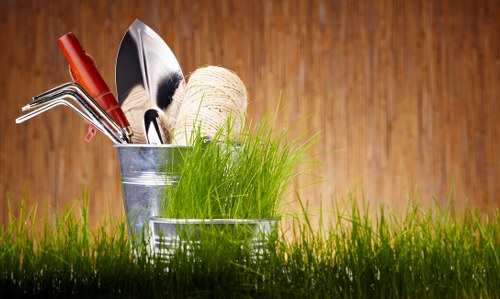Mastering Landscape Gardening: The Art of Hedge Trimming

Landscape gardening is a harmonious blend of art and science, transforming outdoor spaces into aesthetically pleasing and functional environments. Among the myriad of practices that contribute to this transformation, hedge trimming stands out as a fundamental technique. Proper hedge trimming not only enhances the visual appeal of your garden but also promotes the health and longevity of your plants.
Hedge trimming involves the careful shaping and maintenance of hedges to achieve desired forms and sizes. Whether you're aiming for a formal, manicured look or a more natural, flowing style, the principles of hedge trimming remain essential. This article delves into the intricacies of landscape gardening with a focus on hedge trimming, providing insights and tips to help you create and maintain beautiful hedges in your garden.
Understanding the basics of hedge trimming is crucial for any landscape gardener. It involves more than just cutting back overgrown branches; it's about shaping the hedge to complement your garden's overall design. By mastering hedge trimming, you can create stunning focal points, provide privacy, and add structure to your outdoor space.

The Importance of Hedge Trimming in Landscape Gardening
Hedge trimming plays a significant role in landscape gardening for several reasons:
- Visual Appeal: Well-trimmed hedges enhance the beauty of your garden, adding structure and definition.
- Health and Growth: Regular trimming promotes healthy growth by removing dead or diseased branches and allowing better air circulation.
- Privacy: Hedges can serve as natural barriers, providing privacy and reducing noise from the surrounding environment.
- Maintenance: Trimming keeps hedges at a manageable size, preventing them from becoming overgrown and unwieldy.
Incorporating hedge trimming into your landscape gardening routine ensures that your outdoor space remains both beautiful and functional.
Proper maintenance is key to sustaining the longevity and health of your hedges.

Essential Tools for Effective Hedge Trimming
To achieve precise and clean cuts, having the right tools is essential. Here are some tools every landscape gardener should have for hedge trimming:
- Pruning Shears: Ideal for small branches and detailed shaping.
- Hedge Trimmers: Available in manual and electric versions, these are perfect for larger hedges.
- Loppers: Suitable for cutting thicker branches that pruning shears can't handle.
- Hand Saws: Useful for removing very thick branches.
- Protective Gear: Gloves, safety goggles, and proper footwear to ensure safety during trimming.
Investing in high-quality tools not only makes the trimming process easier but also ensures the health of your hedges by providing clean cuts that reduce the risk of disease.

Step-by-Step Guide to Hedge Trimming
1. Planning and Preparation
Before you begin trimming, assess the current state of your hedges. Identify the desired shape and size, and plan your trimming accordingly. It's also crucial to check the weather forecast; avoid trimming during wet conditions to prevent damage to the plants.
Tips:
- Use stakes and string to outline the desired shape.
- Ensure you have all necessary tools ready.
2. Cleaning the Hedges
Start by removing any dead, diseased, or damaged branches. This not only improves the appearance but also promotes healthy growth.
Techniques:
- Use pruning shears for small branches.
- Employ loppers or saws for thicker stems.
Consistency is key to maintaining a uniform look across your hedges.

3. Shaping the Hedges
Based on your initial plan, begin shaping the hedges. For formal hedges, aim for straight lines and sharp angles. For more natural looks, follow the inherent growth patterns of the plants.
Best Practices:
- Trim in layers, starting from the top and working your way down.
- Regularly step back to assess the overall shape.
4. Finishing Touches
After shaping, go over the hedges to smooth out any uneven areas. Ensure that the hedge receives adequate sunlight and air circulation by avoiding overly dense trimming.
Maintenance Tips:
- Schedule regular trimming sessions, typically once or twice a year.
- Monitor hedge health and adjust trimming practices as needed.
Maintaining your hedges ensures they remain a beautiful and functional part of your landscape garden.
Choosing the Right Plants for Your Hedges
The success of your landscape gardening and hedge trimming efforts largely depends on the types of plants you choose for your hedges. Here are some popular options:
- Boxwood: Known for its dense foliage and ability to be shaped into formal designs.
- Privet: Fast-growing and versatile, ideal for creating privacy screens.
- Laurel: Thick and evergreen, providing year-round greenery.
- Holly: Adds a touch of color with its bright berries and glossy leaves.
- Yew: Tolerant of heavy trimming and excellent for intricate shapes.
Selecting the right plant ensures that your hedges thrive and complement your overall landscape design.
Consider factors such as climate, soil type, and the level of maintenance you're willing to commit to when choosing your hedge plants.
Advanced Hedge Trimming Techniques
Topiary Art
Topiary involves shaping hedges into decorative forms, such as animals or geometric shapes. This technique requires precision and creativity, adding a unique touch to your landscape garden.
Steps:
- Choose slow-growing plants for better control.
- Use sharp tools to make clean cuts.
- Trim regularly to maintain the desired shape.
Layered Trimming
Layered trimming creates depth and dimension within your hedges. By trimming different heights and layers, you can achieve a more dynamic and visually appealing look.
Benefits:
- Enhances light penetration and air flow.
- Adds visual interest and complexity.
Incorporating advanced trimming techniques can elevate the aesthetic of your landscape garden, making your hedges stand out.
Common Mistakes to Avoid in Hedge Trimming
Even with the best intentions, it’s easy to make mistakes when trimming hedges. Here are some common pitfalls and how to avoid them:
- Over-Trimming: Cutting too much can stress the plants and hinder healthy growth.
- Ignoring Plant Health: Trimming diseased or damaged branches is essential for maintaining overall plant health.
- Poor Timing: Trimming during inappropriate seasons can disrupt the plant’s growth cycle.
- Uneven Cutting: Inconsistent trimming can lead to a lopsided appearance.
- Using Dull Tools: Blunt tools can cause ragged cuts, increasing the risk of disease.
By being mindful of these mistakes, you can ensure your hedge trimming efforts yield the best results.
Attention to detail and proper technique are essential in avoiding these common errors.
Maintaining Healthy Hedges
Watering Practices
Proper watering is vital for the health of your hedges. Ensure that your plants receive adequate moisture, especially during dry periods. However, avoid overwatering, which can lead to root rot and other issues.
Recommendations:
- Water deeply but infrequently to encourage deep root growth.
- Use mulch to retain moisture and regulate soil temperature.
Fertilization
Feeding your hedges with the right nutrients promotes robust growth. Choose a fertilizer appropriate for your specific plant type and follow the recommended application rates.
Tips:
- Apply fertilizer in early spring before new growth begins.
- Avoid over-fertilizing, which can damage the plants.
Balanced nutrition is key to producing healthy, vibrant hedges.
Seasonal Hedge Trimming Tips
Spring Trimming
Spring is an ideal time for major hedge trimming as it encourages new growth. Focus on shaping and removing any winter damage.
Actions:
- Prune back any broken or dead branches.
- Shape the hedge to your desired form.
Summer Maintenance
During the summer, perform light trimming to maintain shape and control growth. Ensure your hedges receive sufficient water and nutrients.
Best Practices:
- Regularly remove any new growth that detracts from the shape.
- Monitor for pests and diseases.
Consistent upkeep throughout the growing season keeps your hedges looking their best.
Enhancing Your Landscape with Diverse Hedge Varieties
Incorporating a variety of hedge plants can add diversity and interest to your garden. Combining different species creates a layered and textured landscape, enhancing the overall aesthetic appeal.
- Mixed Hedges: Combine evergreen and deciduous plants for year-round interest.
- Color Variation: Use plants with different leaf colors and textures to create visual contrast.
- Height and Density: Vary the height and density of your hedges to add depth and dimension.
Experimenting with different hedge varieties allows you to customize your landscape garden to reflect your personal style and preferences.
Eco-Friendly Practices in Hedge Trimming
Using Sustainable Tools
Opt for eco-friendly tools and practices to minimize your environmental impact. Manual hedge trimmers and electric tools are more sustainable options compared to gas-powered equipment.
Advantages:
- Reduce carbon emissions.
- Lower noise pollution.
- Minimal maintenance requirements.
Composting Trimmings
Instead of disposing of hedge trimmings, compost them to create nutrient-rich soil amendments. Composting recycles organic material, enriching your garden's soil and promoting healthier plant growth.
Benefits:
- Reduces household waste.
- Enhances soil fertility.
- Supports sustainable gardening practices.
Adopting eco-friendly practices contributes to a healthier environment and a more sustainable garden.
Professional vs. DIY Hedge Trimming
Deciding whether to trim your hedges yourself or hire a professional depends on various factors:
- Skill Level: Professionals have the expertise to shape hedges precisely and maintain plant health.
- Time: DIY trimming can be time-consuming, especially for larger gardens.
- Tools: Professionals have access to specialized tools, ensuring clean and efficient cuts.
- Cost: While hiring professionals incurs additional costs, it can save time and prevent potential plant damage.
Consider your garden's size, your personal skills, and the desired outcome when making this decision.
Balancing cost and quality is essential in determining the best approach for your hedge trimming needs.
Final Thoughts on Landscape Gardening and Hedge Trimming
Landscape gardening is a rewarding endeavor that enhances your outdoor living space. Hedge trimming is a vital component of this process, offering both aesthetic and practical benefits. By understanding the techniques, tools, and best practices involved in hedge trimming, you can ensure that your garden remains beautiful, healthy, and well-maintained throughout the year.
Whether you choose to undertake hedge trimming yourself or enlist the help of professionals, investing time and effort into this task will yield lasting benefits for your landscape garden.
Take the next step in transforming your garden by mastering hedge trimming today.
Contact us today to learn more about our expert landscape gardening services and let us help you create the garden of your dreams.